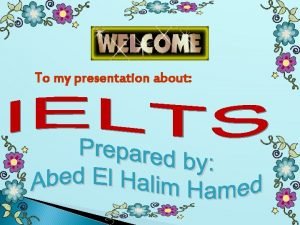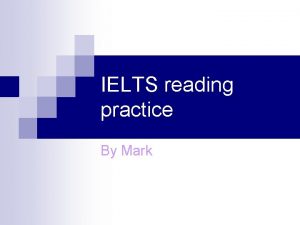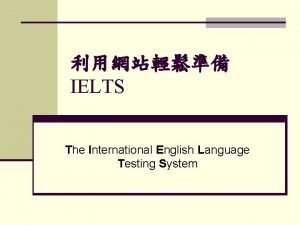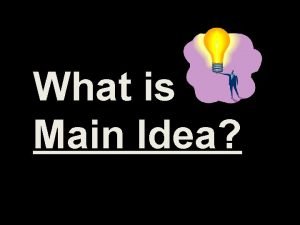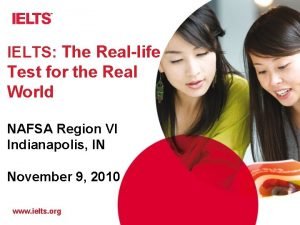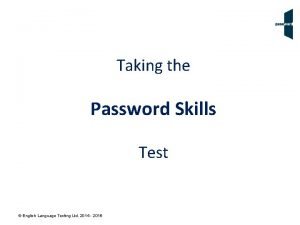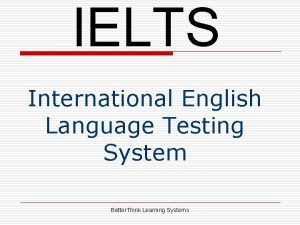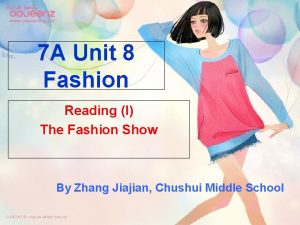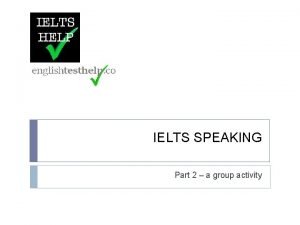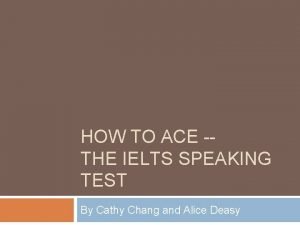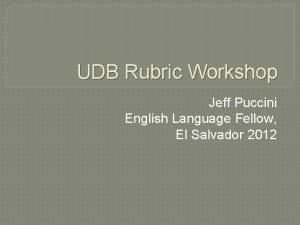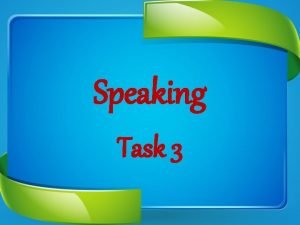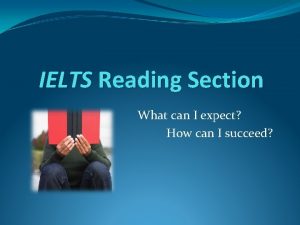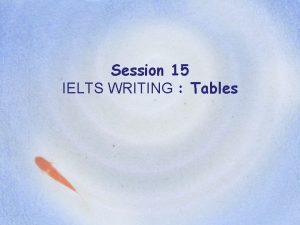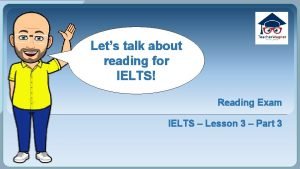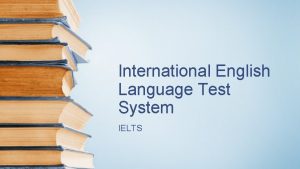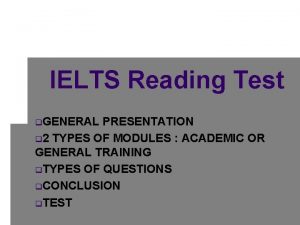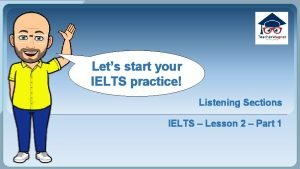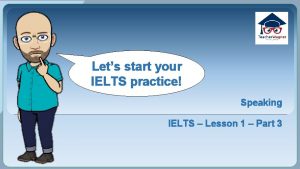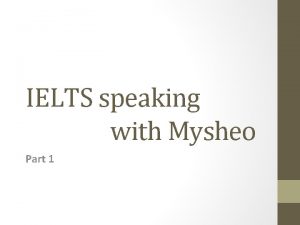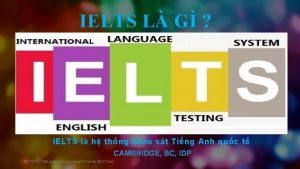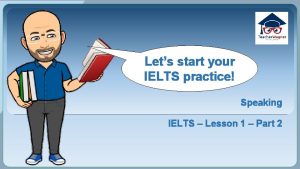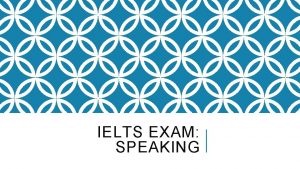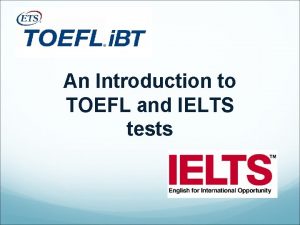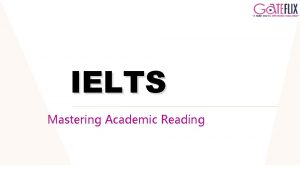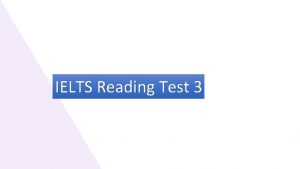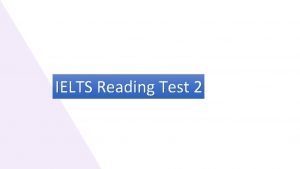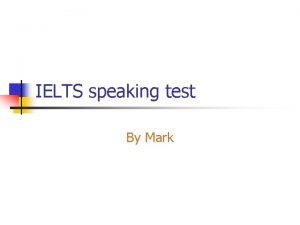IELTS Reading Test General Presentation 2 Types of

























- Slides: 25

IELTS Reading Test • General Presentation • 2 Types of Modules: Academic or General Training • Types of Question • Conclusion

Introduction • The Reading module takes 60 minutes • There are 40 questions • Based on three reading passages with a total of 2000 words. • 2 types of Reading Test : Academic or General Training Reading. • They both have the same format. • All answers must be entered on an answer sheet.

Tips for IELTS Students • Always read the instructions to the task • Do not spend more then 20 minutes on each section as you may not have enough time to complete • As the IELTS reading paper covers a variety of writing styles make sure you prepare yourself for this by reading news papers, jurnals, magazines and fictions and non fiction books. • Be prepared to be tested on any subject some one attending a university would be expected to be an expert in all these topics • Some times in IELSTS the questions are written before as well as after the passage. Always check that you have answered 40 questions

Academic Reading • The Academic Reading assess candidates ready to study or train in the medium of English at an undergraduate or postgraduate level. • So. . . for under or post graduate studies (going to University) the academic test is required.

General training Reading • Not designed to test full range of formal language skills • for candidates going to English speaking countries to complete their secondary education, undertake work experience or training programmes or for immigration purposes to Australia, Canada and New Zealand.

Types of questions There are 9 different types of questions: 1. Summary completion 2. Matching headings to paragraphs 3. Identifying the writer’s views 4. Multiple choice. 5. Selecting factors 6. Table completion 7. Matching causes and effects 8. Sentence completion 9. Short answer questions

1. Summary completion • The input for this type of question will be a summary of all or part of the reading text. The summary will contain a number of gaps. You will be provided with a list of words to use to fill the gaps. There will be more words than gaps. Your task is to complete the summary using one word from the list for each gap.

Summary completion – example Type Complete the summary below. Choose your answers from the box at the bottom of the page and write them in boxes 1 -8 on your answer sheet. NB There are more words than spaces so you will not use them all. You may use any of the words more than once. List of Words passengers happy float advanced lifeboats confident dangers ocean worried inadequate enormous excitement fast handbook water afloat record fast procedures orders drown size sink safety

2. Matching headings to paragraphs • In this type of question, you will be given a list of headings. The instructions will also indicate around 4 to 6 paragraphs from the reading text. The task is to find the most suitable heading for each of the paragraphs. There will be more headings than paragraphs, and you shouldn’t use any heading more than once unless the instructions tell you that you can. The correct heading will sum up the main idea of the paragraph.

Matching headings - example Type 2. Choose the heading which best sums up the primary cause of the problem described in paragraphs D, E, G, H and I of the text. Write the appropriate numbers (1 -10) in the boxes on your answer sheet. List of Headings • 1 Ignorance of the impending disaster • 2. Captain’s orders ignored • 3 Captain’s over-confidence • 4 Rough sea conditions • 5 Faulty design • 6 Iceberg locations not plotted • 7 Low priority placed on safety • 8 Number of lifeboats adequate • 9 Inadequate training • 10 Ice warnings ignored

3. Identifying the writer’s views • In this task type you will be given a number of statements. You will have to decide if these statements agree with the writer's views. To complete this task well you will often need to be able to recognise the writer’s views not only from what is said directly, but also from what is implied.

Identifying the writer’s views - example Type 3 Do the following statements agree with the views of the writer in the reading passage? In boxes 1 -7 on your answer sheet write: • Yes If the statement agrees with the writer • No If the statement contradicts the writer • Not Given If it is impossible to say what the writer thinks about this

4. Multiple choice In this question type you will be given a ‘stem’ which may be an incomplete sentence or a question. The stem will be followed by three or four options – one will be correct (the answer) and three may seem possible but are in fact incorrect in some way (the distracters). In tackling this type of question, it is very important to read the stem carefully. Candidates often make careless mistakes when they misread the stem and so choose the wrong option.

Multiple choice - example Type 4 Choose the appropriate letters A-D and write your answers in boxes 1 -3 on your answer sheet. 1. Which is most at fault for the magnitude of the Titanic disaster? A. The ship B. The Titanic’s owners and builders C. Standard operating procedure D. The captain and crew 2. The number of lifeboats on the Titanic … A. would have been sufficient if all boats had been filled to capacity B. met the regulations for much smaller ships but not the Titanic C. had been designed in 1894 by the British Board of Trade D. could carry more people than required under the regulations 3. The Titanic was … A. higher than the tallest buildings of her day B. divided into 16 watertight compartments C. unsinkable D. the most technologically advanced liner of her time

5. Selecting factors • You will be provided with a number of statements some of which paraphrase or summarise what the writer said. In this task type you need to show that you know what information the writer did (and did not) mention on a particular topic.

Selecting factors – example type 5 The writer mentions a number of factors related to poor communication which contributed to the disaster. Which 3 of the following factors are mentioned? Write your answers (A-H) in boxes 1 -3 on your answer sheet. • • A. The Titanic was travelling too fast. B. Ships were not required to operate their wireless continually. C. There were insufficient lifeboats on the ship. D. The Titanic’s wireless was not operating around the clock. E. Ice warnings were not dealt with systematically. F. The Californian’s wireless had broken down. G. The Titanic’s wireless had broken down. H. Captain Smith did not give his officers enough information.

6. Table completion You will be provided with an incomplete table which summarises or paraphrases information given in the reading text. The information in table form may be organised differently from the way in which it appears in the text, for example chronologically instead of in order of importance. The task is to complete the gaps in three words or fewer.

Table completion – example type 6 Complete the table below using information from the reading passage. Write no more than three words for each answer. Write your answers in boxes 1 -8 on your answer sheet Problem Position of icebergs not plotted Insufficient lifeboats Lifeboats not full Californian didn’t listen to the distress calls Cause of problem the Regulated after the Titanic disaster? (Write Yes, No or Doesn't say) … (1) … scattered Doesn’t say all over the ship … (2) … regulations … (3) … a) ignorance of the … (3) … extent of the danger. . . (6). . . b) fear that the lifeboats would … (5) … No … (7) … wireless … (8) … operation

7. Matching causes and effects • You will be provided with two lists. In most cases, one list contains a small number of causes and the other list contains a larger number of effects. The task is to find the effect which arose from (matches) each cause. To complete this task well you will need to understand clearly what the words ‘cause’ and ‘effect’ mean.

Matching causes and effects -example Type 7 The reading passage describes a number of cause and effect relationships. Match each cause (1 -4) in List A with its effect (A-H) in List B. Write your answers (A-H) in boxes 1 -4 on your answer sheet. NB There are more effects in List B than you will need, so you will not use all of them. You may use any effect more than once if you wish. List A: Causes List B: Effects 1. Outdated regulations designed for much smaller ships 2. Captain Smith’s failure to communicate sufficient information to officers 3. No requirements for 24 hour a day wireless operation 4. Lack of procedures for dealing with wireless messages A. Lack of lifeboat training and drills B. More than two of the watertight compartments filled with water C. Locations of icebergs received in ice warnings were not plotted D. Half full lifeboats did not return to rescue people E. Nearby ship did not come to Titanic’s rescue F. Not enough lifeboats G. Passengers panicked H. Lifeboats were not fully loaded

8. Sentence completion • You will be provided with a number of incomplete sentences which you need to complete using information from the reading text. Generally you must complete the statement in three words or fewer, but confirm this with the instructions.

Sentence completion - example Type 8 Complete the sentences below using words taken from the reading passage. Use no more than three words for each answer. Write your answers in boxes 1 -3 on your answer sheet. • 1. One positive outcome was that the inquiries into the Titanic disaster sought to improve safety procedures by initiating …(1)… • 2. The Titanic’s safety feature, which convinced most people that she wouldn’t sink, was her …(2)… • 3. Passenger ships across the North Atlantic Ocean had an excellent safety record in the …(3)…

9. Short answer questions • You will be provided with a number of questions which you have to answer. Generally your answers must be in three words or fewer but confirm this with the instructions.

Short answer questions - example Type 9 Using no more than three words, answer the following questions. Write your answers in boxes 1 -3 on your answer sheet. • 1. Alexander Carlisle implied that the Titanic’s owners were more concerned about the ship’s appearance than what? • 2. The laws of which government regulated the lifeboat requirements that the Titanic conformed to in 1912? • 3. What term used in the passage tells the reader that this was the Titanic’s first journey?

Tips • Read the instructions carefully • Read the questions first but not always the options – can be good to predict first • Skim / scan as appropriate (general / detailed) • Pay special attention to subheadings, first sentences of paragraphs • Names, numbers stick out • Don’t read everything! • Predict answers for gaps – make sure answers fit logically… • …as well as grammatically • Stuck? Move on to easier one – don’t waste time
 Q scores meaning
Q scores meaning Ielts reading introduction
Ielts reading introduction Ielts exam net reading
Ielts exam net reading The lake erie canal ielts reading answers
The lake erie canal ielts reading answers Ielts org
Ielts org While reading activities
While reading activities Ielts test scores
Ielts test scores Password skills test vs ielts
Password skills test vs ielts Ielts listening test
Ielts listening test What is post reading stage
What is post reading stage Cefr ielts
Cefr ielts Ielts abbreviation
Ielts abbreviation Disadvantan
Disadvantan Better think ielts
Better think ielts Unit 8 fashion and design ielts answers
Unit 8 fashion and design ielts answers Italia breaks ielts listening
Italia breaks ielts listening Ielts speaking part 2 activities
Ielts speaking part 2 activities Ace the ielts
Ace the ielts Ielts cerf
Ielts cerf Eco holiday ielts speaking
Eco holiday ielts speaking Pembersihan karang gigi
Pembersihan karang gigi Idp ielts
Idp ielts Ielts
Ielts Essay discussing the advantages and disadvantages
Essay discussing the advantages and disadvantages Ielts
Ielts Junior ielts
Junior ielts
